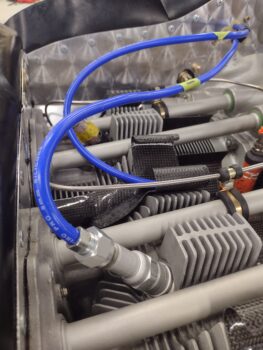As I entered the shop this morning and turned on all the lights, I realized that the front of the shop was notably darker than before. Now, I’ve had a few of my older fluorescent light bars give up the ghost (or just need new bulbs), but these lights were my “new” LED shop lights that I have daisy chained in a square pattern around an older fluorescent light bar, for the front and aft of each work bay.
Upon closer inspection I realized that this was part of a surreptitious squirrel operation, a continuation of my ongoing war with them. I’m guessing now that ALL the ceiling insulation is gone, that they’re pissed and resorting to shenanigans as payback.
After more reconnaissance I discovered that not only did they gnaw through 4 light power cords, but also 3 of my 4 shop speaker wires as well. And we’re not talking a single cut, these little bastards gnawed them all into smaller lengths… some only 1-2 feet long.
Well, I spent nearly an hour figuring out their terror campaign and fixing the wiring to the 4 front lights. On 2 of the lights I left the cord dangling in midair, so it should prove harder to get access to gnaw through. I’ll work the speaker wire a bit here and there, since I have at least one speaker for music. Crazy.
My next op was to get the new pressure switch installed on my shop compressor. Clearly when I built the closet for my shop compressor, I didn’t have in mind having to swap out a pressure switch. In fact, in all my compressors that I’ve owned over the years I’ve never had to swap out a pressure switch.
To gain access to my compressor I have to take off a fairly thick hatch (to mitigate sound). I then quickly realized that to have any chance of working on the pressure switch, which is on the left side looking in at the compressor, that I would need to unbolt 2 of the 3 legs and rotate the compressor as much counterclockwise in the closet that I could.
After a good 30 minutes of trying in vain to get the pressure switch out, I had to step back and evaluate how they assemble these compressors at the factory, because that thing was not coming out. I realized that the entire manifold block had to come out, so I spent another half hour getting that thing unburdened by what was (ha!). I then gave it a good cleaning.
A little interesting in sourcing this new pressure switch is that I could only find the exact replacement part number item for around $120. That is a pressure switch that cuts on at 145 psi and cuts off at 175 psi… in theory, since my original one cut off a little over 150 psi.
During my research, I found one at Tractor Supply that cuts on at 125 psi and cuts off at 150 psi, but a comment by a user warned potential buyers that when he hooked his up it cut off around 170 psi: so test it first. He found an adjustment screw and dialed it down. Hmmm, if it was adjustable, and started high, then I could do the same thing in reverse. And at half the cost, $60 was sounding much better than $120.
Well, enter our friends at Amazon. They had the exact same unit as Tractor Supply for less than $40… sold! Notice the faceplates above are exactly the same. And the switch body is nearly identical except the new one has 3 extra ports, and the label is different. Beyond that, they’re pretty much the same switch as far as I can tell.
Besides just wanting to use my shop compressor in normal fashion, I specifically wanted it back online to use during my machining ops. Moreover, I’ll be micro-finishing the top fuselage, strakes, wings, etc. coming up here soon and I do not want to face that job without my magical “air file.” So it was time to get this compressor back online.
I got the pressure switch installed and even though I turned the set screw to jack up the PSI kick in/out, it’s still around 150 psi. It works though and tomorrow I’ll tweak the pressure cut in/out, reset the compressor in place, bolt it in and close up the compressor closet.
In the meantime, I ops tested it by machining the triangular gas cap securing tabs, that ensure if I for some reason forget to lock a gas cap closed that it doesn’t fly off into my prop.
Here’s a short video I made of machining those gas cap tabs.
And here are the machined tabs, if you’re not in the mood to watch the video!
I had a late dinner before knocking out my final task for the day: solder-splicing the alternator F-lead inside the hell hole. I cut the wires to length, spliced them together using Bob Nuckoll’s method (extra wraps of wire)… sorry for the wire being the main unfocused thing in the pic. My camera sucks!
I then soldered the wires together, covered the splice with red heat shrink and also heat shrank a label in place nearby the splice. Now my alternator is officially wired to the front side of the plane!
And with that folks, I called it a night.









































































